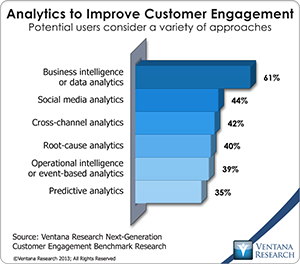In 2013 we continued to see change in the contact center, customer service and customer experience markets: Consumers’ communication habits continued to evolve, more business units outside the traditional contact center became involved in handling interactions, software vendors continued to come up with new technologies, and cloud computing, mobility, big data, collaboration, social media and analytics all had a big impact on the ways users access and consume software. Many of these trends surfaced in my benchmark research on next-generation workforce optimization and next-generation customer engagement. Overall my research shows that organizations are slowly maturing in terms of the people, processes, information and technology they use to support customer engagement and related customer-facing activities. However, it also shows that many of the old issues have not gone away and that companies still have work to do to meet customer expectations and achieve their business goals.
and next-generation customer engagement. Overall my research shows that organizations are slowly maturing in terms of the people, processes, information and technology they use to support customer engagement and related customer-facing activities. However, it also shows that many of the old issues have not gone away and that companies still have work to do to meet customer expectations and achieve their business goals.
There was a lot of talk during the year about the omni-customer experience, which we define as providing customers with in-context, consistent, personalized experiences at every touch point throughout the customer life cycle. I am on record as saying most companies are a long way from delivering it, so as we enter 2014 here are some recommendations that might help businesses move in that direction.
Develop a complete view of the customer.
I don’t see how companies can provide an omni-customer experience without having a complete view of their customers. Without one, marketing cannot focus campaigns to the right market segment, through the right communication channels; sales cannot personalize offers based on customer profiles and preferences; customer service cannot tailor service to meet business and customer expectations; and contact centers cannot route calls to the best person to address an issue.
Optimizing the customer experience requires information about customers, their communication preferences, their propensities to recommend or criticize, and their likely future actions. My  research into customer relationship maturity shows that only 31 percent of organizations claim to have a single set of reports and analysis about their customers, and for many of them producing a single, complete view is a real headache now that they have to process greater volumes of customer-related data and in more formats (structured and unstructured), including operational data such as network alerts. My research into next-generation customer engagement shows that companies are slowly adopting tools to handle analytics for speech, text, social media, and the agent desktop, predictive analytics and operational intelligence in efforts to produce this elusive 360-degree view, but many have a long way to go. Organizations have to wrestle with big data, find tools that can process huge volumes of different types of data and produce information in near-real time. Those that have adopted big data customer analytics have realized significant benefits, including improvement in customer service and customer satisfaction scores. Early in 2014, I will deliver on my benchmark research on next-generation customer analytics, including best practices companies should adopt to improve the use of these analytics but also find best path to access and integrate data across enterprise and cloud. My colleague recently provided results on location analytics that provides insights to a critical attribute of where to interact and engage customers.
research into customer relationship maturity shows that only 31 percent of organizations claim to have a single set of reports and analysis about their customers, and for many of them producing a single, complete view is a real headache now that they have to process greater volumes of customer-related data and in more formats (structured and unstructured), including operational data such as network alerts. My research into next-generation customer engagement shows that companies are slowly adopting tools to handle analytics for speech, text, social media, and the agent desktop, predictive analytics and operational intelligence in efforts to produce this elusive 360-degree view, but many have a long way to go. Organizations have to wrestle with big data, find tools that can process huge volumes of different types of data and produce information in near-real time. Those that have adopted big data customer analytics have realized significant benefits, including improvement in customer service and customer satisfaction scores. Early in 2014, I will deliver on my benchmark research on next-generation customer analytics, including best practices companies should adopt to improve the use of these analytics but also find best path to access and integrate data across enterprise and cloud. My colleague recently provided results on location analytics that provides insights to a critical attribute of where to interact and engage customers.
Adopt new recurring revenue models.
The Internet has changed many aspects of business. One of the biggest impacts is the way companies access and consume software. The acceptance of cloud computing has required software vendors to adopt cloud-based strategies that allow their customers to access their software over the Internet. My research shows that most companies don’t particularly care about the detailed model. For them the key factors are that the software is off premises, they need virtually no resources to maintain or operate the software and, crucially, the payment model is different, typically involving a monthly fee tied to usage. This is nothing new to telecom service providers, most of which have taken the model one step further by providing bundled services with package discounts and complex usage-based charges. The success of this model means that more traditional businesses have been exploring options to transition to an Internet-based recurring revenue strategy, with providers now allowing companies to rent hardware based on usage, consumers downloading videos and music instead of renting from stores, and consumers sharing and selling all manner of goods over the Internet.
Such a model has both benefits and challenges. The primary benefit is that most customers commit to a longer term relationship, which generates revenue on a recurring basis, and that revenue is based on recurring (typically monthly) fees and usage-based charges. The challenge is that companies need systems that can create product and service catalogs; manage the customer life cycle from marketing through sales, billing and service; collect and calculate the cost of usage charges; and provide either embedded accounting or links to existing accounting systems. Crucial to success is managing customer engagement throughout the life cycle. Companies must make it easy for customers to see information about their service and usage through the channel of their choice and provide billing through different channels. They must also handle interactions quickly, provide accurate and personalized responses, and proactively reach out to their customers with new offers. My next benchmark research will cover the recurring revenue model and provide insight into best practices, challenges and opportunities.
Innovate for the next generation of customer self-service.
Self-service enables and encourages customers to use channels that don’t include speaking with a representative. My research into customer relationship maturity shows that until now these initiatives have largely been unsuccessful, with customers often resorting to calling the contact center when things don’t work as expected or the information provided doesn’t meet expectations. Social media tools and mobile customer service apps enable companies to address these issues, allowing customers to begin in self-service mode and, if necessary, seamlessly transfer to a person without having to repeat data they have already entered. My initial research and interviews with companies that have successfully used these methods indicates that success comes through designing the user interface with the customer in mind and deploying services that meet the customer’s – not the company’s – expectations. New development tools help companies create mobile apps that offer a real opportunity to provide customer-driven self-service as well as a seamless and effective channel into the contact center if the need arises.
 Another technology impacting the customer experience is voice recognition. This technology has advanced considerably over the past few years, and services such as the iPhone’s Siri are creating the expectation that consumers can talk to devices rather than click buttons. This involves voice-controlled software agents that are programmed to follow predefined call flows and thus deliver consistent customer experiences that don’t depend on agent intervention. I intend to do research on customer self-service later in 2104, and that will include best practices in use of customer portals, mobile apps, social media and virtual agents. I did complete in 2013 a full assessment we call Value Index on agent desktop vendors and software for contact centers and plan to add contact center in the cloud and customer analytics to the list of new Value Index research.
Another technology impacting the customer experience is voice recognition. This technology has advanced considerably over the past few years, and services such as the iPhone’s Siri are creating the expectation that consumers can talk to devices rather than click buttons. This involves voice-controlled software agents that are programmed to follow predefined call flows and thus deliver consistent customer experiences that don’t depend on agent intervention. I intend to do research on customer self-service later in 2104, and that will include best practices in use of customer portals, mobile apps, social media and virtual agents. I did complete in 2013 a full assessment we call Value Index on agent desktop vendors and software for contact centers and plan to add contact center in the cloud and customer analytics to the list of new Value Index research.
Companies can use any of these exciting developments to improve the ways they engage with customers. However, my research shows that many are so tied up with resolving day-to-day issues that they don’t have time to evaluate new tools; thus they miss opportunities that could not only resolve their problems but also address key issues such as improving the customer experience. During 2014 I will be tracking vendor developments in all of these areas, and I hope to help you handle both your current issues and new initiatives to optimize the customer experience. If you want to download the research agenda, anyone can come to our community and download.
Regards,
Richard J. Snow
VP & Research Director - Customer












